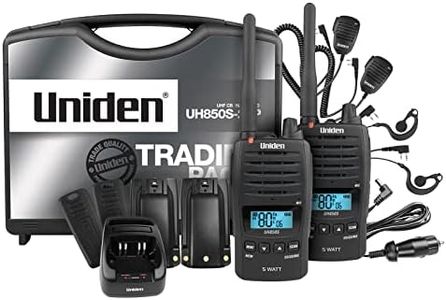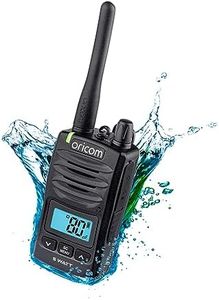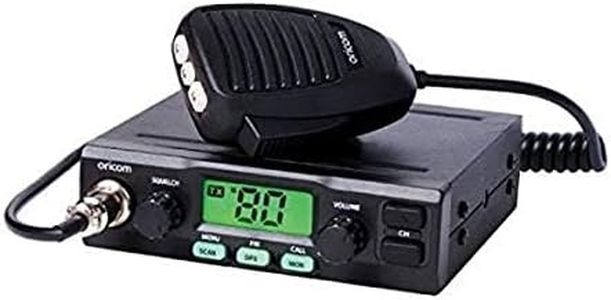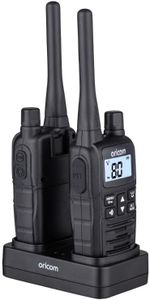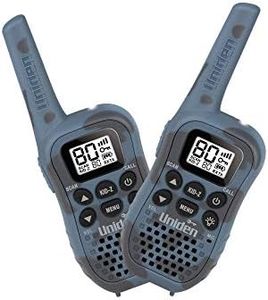We Use CookiesWe use cookies to enhance the security, performance,
functionality and for analytical and promotional activities. By continuing to browse this site you
are agreeing to our privacy policy
9 Best Handheld Uhf Radios
From leading brands and best sellers available on the web.Buying Guide for the Best Handheld Uhf Radios
Choosing a handheld UHF radio is all about matching the device to your intended use. These portable radios are invaluable tools for communication, especially when you’re outdoors, working in teams, or need reliable links in areas where cell phone coverage is weak. To pick the right radio, you’ll want to understand what features matter most for your environment and needs. Consider how far you need to communicate, how rugged the device needs to be, and which extra functions could make your experience smoother or safer. By focusing on key specs and thinking about where, how often, and in what conditions you'll use the radio, you can narrow down the best options for you.Frequency Range (UHF Coverage)The frequency range determines the span of channels your radio can access. In UHF radios, this usually sits between 400-520 MHz, suitable for indoor use or urban areas because UHF waves work well around obstacles like buildings. A wider frequency range offers more flexibility and access to different channels, which can reduce interference. If you need a radio for densely packed areas or complex environments, prioritize a model with a broad frequency range, but remember that only certain frequencies may be legally available for public or commercial use depending on your region.
Output PowerOutput power, measured in watts, impacts how far your radio can communicate. Handheld UHF radios usually provide between 1 to 5 watts. Lower power (1-2 watts) conserves battery and is suitable for short distances, such as within a building or close group outdoors. Higher power (4-5 watts) extends range, helpful for covering larger areas or operating in outdoor environments. Consider if you mainly use the radio indoors or in close proximity (go for lower power), or if you need to reach partners further away or in challenging terrains (choose higher power).
Number of ChannelsThe number of channels affects how many unique groups you can communicate with. Radios range from a few preset channels up to hundreds. More channels are useful in environments with many users, since you can easily avoid interference from others. If you’re using the radio with a small group or in a quiet area, fewer channels might suffice. For teams, events, or busy locations, more channels offer vital flexibility.
Battery Life and TypeBattery life is crucial, especially for long shifts or adventures away from power sources. Radios use different battery types, like rechargeable lithium-ion, nickel-metal hydride, or replaceable alkalines. Long battery life (typically 10+ hours) is essential for extended use, while quick-replace batteries are key in emergencies. Think about how often and where you’ll use the radio—if you can’t recharge easily, prioritize models with longer life or swappable batteries.
Ruggedness and Weather ResistanceThis refers to how tough and weatherproof the device is. Ratings like IP (Ingress Protection) can tell you how well the radio resists dust and water. For occasional indoor use, this may not matter much. But if you plan to use your radio outdoors, in the rain, dust, or during active jobs, look for higher IP ratings or military-grade certifications. This ensures your device survives harsh conditions, drops, and splashes.
Size and WeightThe size and weight of a handheld radio decide how comfortable it is to carry around all day. Compact, lightweight models are easier to tuck into a pocket or clip onto a belt, making them ideal for everyday carry or activities like hiking. Larger, heavier radios may offer more power or features but can be cumbersome if you need to stay light. Reflect on your typical usage—if portability and convenience matter, go for smaller units.
User Interface (Display and Controls)A clear display and intuitive controls make the radio easier to use, especially in stressful moments or low-light conditions. Radios with larger screens or simply laid-out buttons are easier to operate, which is helpful for beginners or situations where you need quick adjustments. If you expect to hand radios to people with varied experience or need rapid channel changes, prioritize easy-to-read displays and simple buttons.
Additional FeaturesMany radios include extras like VOX (voice-activated transmission), emergency alarms, built-in flashlights, or programmable buttons. While these features aren’t essential for everyone, they can provide safety and convenience, especially in challenging or unexpected scenarios. Decide which extra features suit your activities—like an emergency alert for hiking or hands-free operation for busy worksites.

